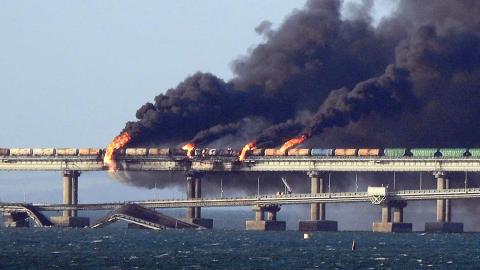A pall of pessimism hangs over Western supporters of Ukraine. With Kyiv’s counteroffensive underperforming most observers’ expectations, a fatalistic attitude bordering on defeatism has set in from Washington to Berlin. NBC News and the German tabloid Bild reported last month that U.S. and European officials were deliberating about an end to the war. As Italian Prime Minister Giorgia Meloni told two Russians posing as African officials in a prank call: “We are near the moment in which everybody understands that we need a way out.”
The truth is that there is no easy way out. Moscow has repeatedly made it clear that it will only accept Kyiv’s surrender, and the latter’s underwhelming ground offensive will only have emboldened the Kremlin. The only way to force Russian President Vladimir Putin from his objective is to give Ukraine the means to beat him on the battlefield.
This is not an impossible task, but it requires the United States to keep its nerve, recognize the stakes, and identify the best path ahead.
A successful U.S. strategy for the war in Ukraine should begin by recognizing that Moscow is uninterested in any genuine cessation of hostilities. We already know that Putin views cease-fires as instruments of war. From 2014 to 2022, as Ukrainian Foreign Minister Dmytro Kuleba has pointed out, Russia agreed to 20 cease-fires in Ukraine—and promptly violated every one of them. Putin may float another such deal in the coming months, but it would only serve one purpose: to give his forces a respite before resuming hostilities.
It is also unrealistic to think Putin would be content with control over the five regions of Ukraine that he has already annexed: Crimea, Donetsk, Kherson, Luhansk, and Zaporizhzhia, only the first of which he fully controls. Of course, the West could attempt to pressure Ukraine into ceding large territories and millions of Ukrainians to Russia in hopes of appeasing Putin, even though Kyiv would fiercely and justifiably resist such a move. It would destroy the relationship with Kyiv, tank morale throughout Ukraine, and raise doubts about U.S. commitments around the world. It would embolden Putin to pocket his gains and press onward.
Such a gambit might make sense if Ukraine were on the brink of collapse and blind to its own peril, but it is nowhere near that point. Ukrainians are convinced of the need to resist Russia by force of arms and have achieved real success in doing so. Kyiv still has reservoirs of power that it is willing to commit to the fight. To give up on Ukraine now would be entirely premature.
In 2022, Ukraine achieved major victories, liberating nearly half of the territory which Russia had occupied since the start of its full-scale invasion. If this year’s ground offensive proved less successful than anticipated, it has much to do with U.S. dithering in providing key weapons, such as the Army Tactical Missile System (ATACMS) and Dual-Purpose Improved Conventional Munitions (DPICMs). This allowed Russia valuable time to dig in.
Moreover, Washington’s prohibition on Ukraine’s use of Western-supplied weapons to strike Russian territory further handcuffed Kyiv. As one of the authors of this piece wrote last spring, before Ukraine’s counteroffensive began: “If Ukraine’s counteroffensive stalls, or even fails, it’s no excuse to end support. On the contrary, it would be a time to learn from mistakes, keep the weapons flowing and the training going and prepare Ukraine for the war’s next phase.”
That phase begins now.
In this new phase, the West should consider bolder and more creative options for supporting Ukraine. Rather than search for off-ramps that don’t exist, it should focus its efforts on moving Ukraine closer to victory with a sustained focus on Crimea, which retired U.S. Army Lt. Gen. Ben Hodges has rightfully described as the war’s “decisive terrain.”
Without the liberation of Crimea, Ukraine will never be safe. The occupied territory is the key staging ground and resupply base for Russian operations in southern Ukraine. As a first step, Ukraine must deny Russia the freedom to operate from Crimea.




















